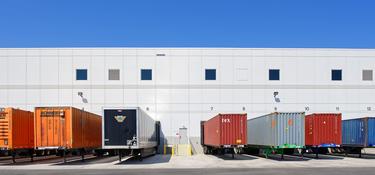
What are distribution centers?
Distribution centers are an often overlooked component of the crucial supply chains that keep factories humming, keep store shelves stocked and ensure that e-commerce works for millions of consumers. These buildings, generally one story and covering large footprints, connect factories where goods are produced and the retail and individual consumers who buy goods. Once products are made – shoes, dishwashers, furniture, books, to name a few – they are sent in bulk, usually by truck, to strategically located distribution centers. From there, companies or distributors manage distribution of smaller shipments of the goods to distributors, stores or, increasingly, individual customers. Distribution centers are designed to facilitate the easy and efficient delivery and pick-up of shipping containers.
Where are distribution centers located?
Typically, distribution centers are located at or near important transportation hubs. In coastal areas, they are often constructed adjacent to seaports. Many are located near airports that have significant cargo operations or next to significant railroad cargo hubs. Throughout the U.S., distribution centers have often been built near the junction of major interstate highways, affording easy access to trucks.
How have distributions centers changed in recent years?
It is increasingly common to find distribution centers located close to populous areas. These distribution centers often have smaller footprints and serve a slightly different function than their suburban or rural analogues. That’s largely due to the growth of e-commerce. With next-day and same-day delivery increasingly the norm for an expanding number of e-tailers, distribution centers are evolving into fulfillment centers. Highly automated, and stocking a large number of items, these distribution centers enable a small number of employees to handle a high volume of individual shipments and process returns.
What is the economic importance of distribution centers?
Distribution centers have a series of positive impacts on the economy and on their community. They abet and enable commerce, provide employment for hundreds of thousands of people, and generate significant amounts of property and other taxes for communities. In addition, today’s state-of-the-art distribution centers are designed for low environmental impact. Many distribution centers also function as platforms for large solar arrays on their roofs.


